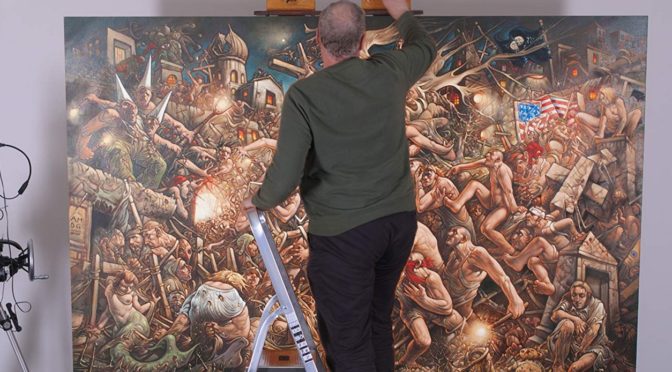Peter Howson sends us on a ‘fast-track to Hell’ in a fascinating look at the creation of his tragically alluring work; Prophecy. Director Charlie Paul sensitively allows Howson plenty of space to work in a peaceful, almost hypnotic state as he documents the artistic process with meticulous detail.
Following an oil painting from its conception in Howson’s Scottish home to eventual sale in New York, Charlie Paul has crafted a simple yet compelling film. The film has an appealingly intimate view, with Howson often speaking as a disembodied voice while the camera observes him go about his work in a sparse, white room. The large canvas is the sole focal point, removing any distraction as the artist isolates himself with his apocalyptic vision.
It is quite remarkable simply to watch a talented artist exhibit their craft. Howson gives a low-key lecture in art history, offering his own musings on the various techniques required to bring about a scene from his own imagination. Pained, contorted bodies pile over each other in desperate anguish at the foot of Christ on the Cross, while the cruel statue of a ‘jester king’ towers over proceedings. The scene rejects any specific notion of time or place, or reality or fantasy. The figures are both inhuman and terrifyingly relatable, the background architecture is borrowed from different cultures, and a foray into ancient mythology with a constrained mermaid conjure feelings of fear and temptation in the seductive unknown. Paul ensures that the camera always has something different to focus on, with close-ups revealing minute details, various mini-stories teased in each corner of the work, and time-lapse photography demonstrating the evolution of the painting – a ghostly, fiery apparition fleshed out into an animated collage of despair.
The use of music greatly enhances the viewing experience, creating an ever-changing tone that echoes the different figures’ emotions. The film opens with the camera gliding across the construction of the canvas frame, hammering wooden planks together with a melancholic, oppressive score that arouses religious imagery of the building of the Cross. As Howson takes a break to explain some of his influences, alternate tunes appear as he flicks through old comics of horror, Tintin and the Moomins, who are backed with a vintage sci-fi theme that evokes memories of all things spooky and wonderfully strange.
Howson is honest without ever boasting or seeking sympathy as he reflects on his personal flaws, his career and the persistent fear of ruining or losing control of his work. The prospect of being consumed by one’s work is something many artists contemplate and Howson speaks openly about his macabre obsession with death. For Howson, the entrance to Hell is a real and vivid sight, as he briefly recounts his hedonistic lifestyle of alcohol and drugs before finding his own salvation. He casually mentions voices in his head and how he was ‘infested with evil’ as if it were commonplace. Diagnosed with Asperger’s, his work is an act of therapy. His grisly paintings are a form of exorcism, confining his demons to inhabit the worlds he creates for them.
Living alongside these demons and tortured souls are that of his disabled daughter Lucie, who is incorporated into much of his work. He turns her pain into beauty, admirably celebrating her uniqueness over bland normality. In this specific painting, she holds a crown of thorns, to which Howson comments that holy relics possess certain healing properties. In this, he allows the scene a hopeful note. There can be elegance and purity in tragedy.
Howson describes the process of painting as ‘filmic’, with characters suddenly appearing or being wiped from the scene. Charlie Paul seems to share this sentiment, as he transforms the process of painting into something epic and satisfying to behold. It is a shame to see the painting sold and Howson parted from his creation, now that the story has been told and the characters resigned to their fate. In his own words, ‘the final brushstroke really is the end of existence’.

